Article | Northwest Passage
Part 2: Gory, Glorious, Uproarious—Early Europeans and the Search for the Northwest Passage
By Aaron Spitzer | October 09, 2020
Related expedition: The Northwest Passage

© Library and Archives Canada
A 1743 hand-coloured map of Hudson Bay, Hudson Strait, Baffin Bay, Davis Strait, and the Labrador coast, created by C. Middleton










